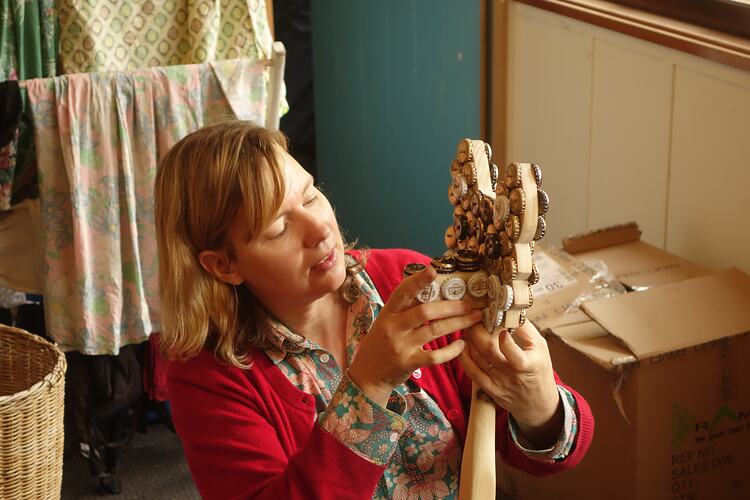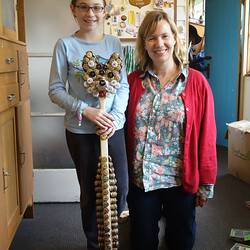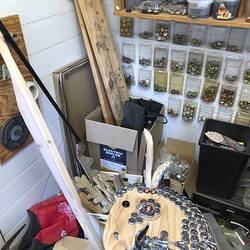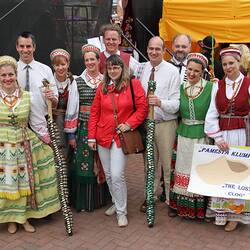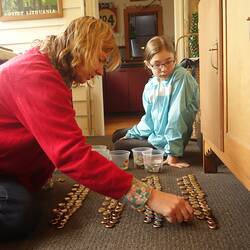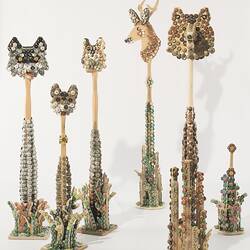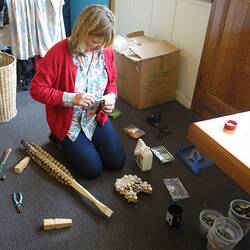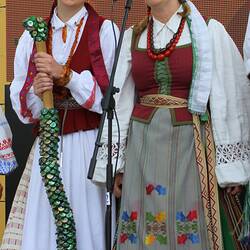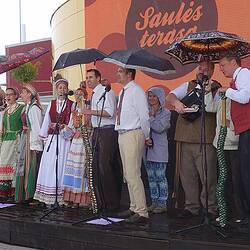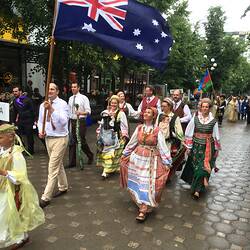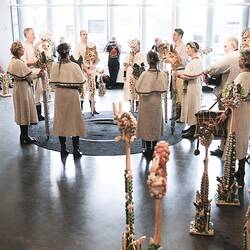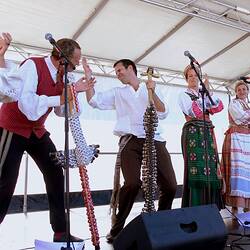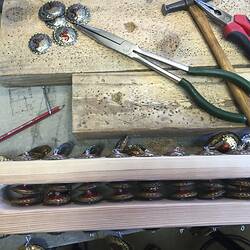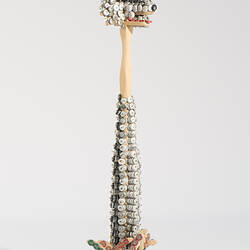Summary
Jazmina Cininas is the daughter of Lithuanian post World War II migrants and explores her multi-faceted personal and cultural identity through diverse creative practices.
Lagerphones - an Australian and Lithuanian Cultural Merging: The lagerphones created by Melbourne artist Jazmina Cininas take the iconic Australian bush band musical instrument and adds the shapes of Baltic nature motifs to evoke a visual, auditory, and poetic reimagining of Lithuanian traditions. Artworks in their own right, the lagerphones serve as percussive instruments, which Jazmina first began making for the Melbourne-Lithuanian folkloric ensemble, The Lost Clog, when she joined them in 2011. The Lost Clog performances bring the lagerphones to life through their approach to weave a narrative song cycle of seasons, love, and loss from archaic Lithuanian folksongs. Jazmina's artistic and music practice offers an acknowledgement and celebration of Lithuanian culture that was part of the first wave of non-British, post-World War II migration, recognising the contribution of migrant and refugee populations to Australia's cultural fabric. Jazmina is the daughter of parents who fled Soviet occupation of Lithuania after World War II.
The lagerphones explore themes of cultural preservation, maintenance and adaptation, as well as hybrid identity. Her lagerphones are all created from recycled materials - salvaged timber and used bottle caps (from Australian and international beers) - which is part of her evolution towards environmentally sustainable art practice while exploring her own Lithuanian-Australian identity. This particular lagerphone represents Vilkas (wolf), which appears in numerous Lithuanian folk songs and children's folk stories. The wolf is a particularly significant animal for Jazmina given her longstanding interest in the representation of female lycanthropy or werewolfism throughout the centuries, which spring-boarded from an exploration ofher own cultural hybridity through the emblem of Vilnius' Iron Wolf. The Vilkas/Wolf lagerphone has previously been exhibited in the trial run of The Sparrow Made Some Beer at Artery Co-operative studies in 2019, also featured in Lost Clog performances at her PhD exhibitions at RMIT and Maroondah Art Gallery in 2014, as well as Jazmina's solo exhibition, Blood Moon Rising at Port Jackson Press in 2016.
Artist Biography:
Jazmina Cininas has exhibited extensively nationally and internationally and her artworks have been shortlisted for numerous art prizes and collected by many significant public collections. While best known for her technically demanding reduction linocut portraits of female werewolves, Jazmina's practice has expanded to include performance and one-off artist books and lagerphones from recycled materials. This conscious shift towards an environmentally sustainable art practice coincides with a more active embracing of her Lithuanian-Australian identity. Jazmina is also a member of the Melbourne-Lithuanian folk group, The Lost Clog (Pamesta Klumpe) as well as a vocalist and lyricist for printmaking concept band, Press Gang.
Artist Statement:
Key to Cininas' lagerphones is an auto-ethnographic exploration of hybrid Australian-Lithuanian cultural identity. By symbolically reinstating a forest from recycled consumer ephemera, the lagerphones also spotlight the excesses of consumer culture while encouraging the reconsideration of waste materials. The lagerphones reflect not only a conscious decision to engage with more environmentally sustainable art practices, but also the legacy of resourcefulness in the face of hardship that she inherited as the daughter of refugees fleeing Soviet occupation and persecution in the aftermath of WWII. At the same time, lagerphones epitomise the Australian bush-band tradition yet are largely consigned to musical kitsch. For The Lost Clog, the instrument acknowledges the Australian half of the group's cultural heritage, serving as a visual and musical 'totem' through which to celebrate its cultural hybridty. Cininas hopes that her playfully elaborate lagerphones will foster awareness and appreciation of under-represented cultural, musical and aesthetic forms, and aid in the preservation and currency of historically sidelined cultural artefacts.
Jazmina's Personal Story:
'I was born in Melbourne to Lithuanian-Australian parents, both of whom had fled Lithuania as children with their parents in the wake of World War II, spending several years in Displaced Persons camps in Germany before finally arriving in Australia in the late 1940s.
My first trip to Lithuania was in 1988, travelling solo as a 22 year old, when it was still Soviet occupied territory. Travel was extremely restricted at that time, but the highlight was a visit to Kaunas to see my grandmother's old home.
The next trip was not until January 2000, as a newly-wed with my husband, Jonas Lipsys, a fellow Lithuanian-Australian. We met singing Lithuanian folk songs around his father's pool table. We both sang with his father for some time, then joined the fledgling Lost Clog when the group was formed in 2010. We have travelled to Lithuania numerous times over the years, most recently in January 2020 for my solo exhibition at the National MK Ciurlionis Art Museum in Kaunas, just before the whole world was plunged into lockdown.
My Lithuanian heritage, specifically the figure of the Iron Wolf, was the impetus for my long-standing exploration of the female werewolf in my art practice, beginning with an autoethnographic exploration of my hybrid cultural identity. This expanded to include broader historical and contemporary representations of female lycanthropy for my PhD, however, in recent years I have returned to a focus on my Baltic-Australian heritage, in both my artist books and the lagerphones. The latter two artforms also utilise recycled materials in a conscious effort to engage with more environmentally sustainable art practices.
More Information
-
Keywords
-
Authors
-
Article types
